U.S. Department of Transportation
Federal Highway Administration
1200 New Jersey Avenue, SE
Washington, DC 20590
202-366-4000
The 2014 Federal Highway Administration (FHWA) Handbook for Designing Roadways for the Aging Population, (Figure 1) contains 33 proven treatments, 18 promising treatments, and 143 recommendations. The Handbook now in its third edition; and under a new title, incorporates the latest research and advancements in treatments since the previous editions were published in 1998 and 2001.

Figure 1. Handbook for Designing Roadways for the Aging Population
The Handbook is composed of two parts. Part I includes recommendations for treatments and countermeasures to address specific areas of concern for aging road users. Treatments focus on five categories of roadway features: intersections, interchanges, roadway segments, work zones, and highway–railway grade crossings. Within each category treatments are classified as a "proven" or "promising" practices. Proven practices are based on supporting evidence drawn from a comprehensive review of field and laboratory research addressing human factors and highway safety. Promising practices are new to this edition of the Handbook and are treatments being used by one or more agencies. Although they are not fully evaluated, they are believed to benefit aging roadway users.
As an example, Chapter 2 of the Handbook focuses on intersections, which is the most serious and enduring crash problem area for aging road users. This particular chapter includes treatments for 16 Proven Practices and 8 Promising Practices.
Some of the treatments recommended for intersection Proven Practices are detailed in Table 1.
Table 1. Treatments Recommended for Proven Practices
| Intersection Proven Practice | Treatment Recommendation |
|---|---|
| Traffic Signals | Install 12–inch signal heads. Provide yellow retroreflective borders on backplates 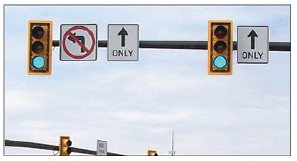 |
| Pedestrian Crossings | Revise walking speed from 2.8 feet per second to 3.0 feet per second. Measure crossing distance 6 feet back from the curb or edge of travel lane. Install countdown pedestrian signals at all signalized intersections. 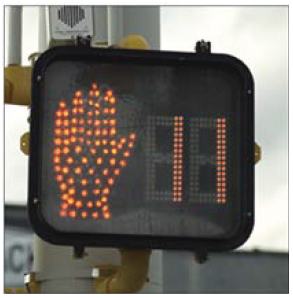 |
| Roundabouts | Provide Advance Warning Signs (W2–6). Provide Directional Arrow Signs (R6–4). Install Roundabout Circulation Plaque (R6–5P). 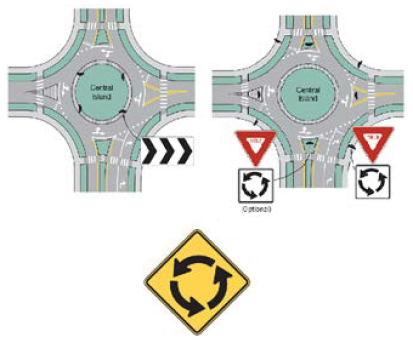 |
Some of the treatments recommended for intersection promising practices are detailed in Table 2.
Table 2. Treatments Recommended for Promising Practices
| Intersection Promising Practice | Treatment Recommendation | |
|---|---|---|
| Right–Turn Channelization Design | Right–turn channelization should be considered during design. A tighter turning radius reduce turning speeds to approximately 17 to 18 mph, decrease pedestrian crossing distances, and optimize the right–turning motorists' line of sight. | 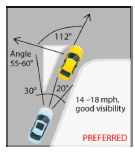 |
| Combination Lane–Use/Destination Overhead Guide Signs | Provide combination lane–use/destination overhead guide signs at intersections with complex design features or heavy traffic. |  |
| Signal Head Visibility | Install one signal head per lane, centered over each lane. | 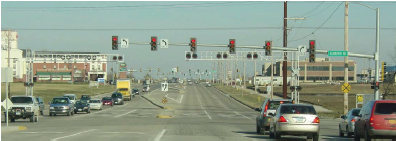 |
| High–Visibility Crosswalks | Use marking patterns that are more visible than standard markings (such as ladder or diagonal patterns). | 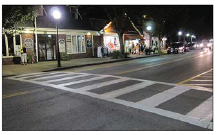 |
| Supplemental Pavement Marking for Stop and Yield Signs | Install word or symbol pavement markings to supplement signs. | 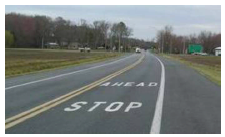 |
Part II of the Handbook presents the rationale and supporting evidence for each treatment.
The Handbook for Designing Roadways for the Aging Population is a resource that practitioners can use to improve the safety of the transportation system for the aging population. To download a copy, visit http://safety.fhwa.dot.gov/older_users.
Agency: Federal Highway Administration
Contact: Rebecca Crowe, Transportation Specialist
Telephone: 202-507-3699
Email: rebecca.crowe@dot.gov
For the 2004 North American Conference on Elderly Mobility (NACEM), the Michigan Department of Transportation (MDOT) partnered with the FHWA and the American Automobile Association (AAA) to develop a 7.4 mile "showcase roadway" (Figure 12). During the conference, tours were organized that allowed attendees to see first–hand selected solutions that benefit elderly drivers.

Figure 2. Older Driver Showcase Roadway in Detroit
For the 2014 NACEM, MDOT invested $137,000 to upgrade five signs to show the side–by–side comparison of the Type XI sheeting versus Type III sheeting and ClearviewTM font versus Series E Mod fonts. MDOT also painted curb islands and curb radii to improve visibility. These enhancements supplemented the safety countermeasures still in place from the 2004 conference including traffic signal backplates, retroreflective borders, pedestrian countdown signals, arrow–per–lane signing, and upgraded sign sheeting for warning signs. With the old and new traffic control devices (TCDs) placed side–by–side, conference attendees could compare the differences.
Upgraded TCDs designed to enhance visibility and increase safety by being easier to read, notice, or understand by older road users, were included in MDOT's showcase roadway. These improvements included:
Government agencies and transportation research facilities around the country researched and extensively tested each of the various TCDs displayed in the 7.4–mile–loop. They found that as drivers age, the ability to read signs becomes increasingly difficult, which is the main reason why the florescent yellow sheeting was used on warning signs instead of high–intensity yellow sheeting1. Another example of specific research that supported the implementation of certain TCDs was conducted by the Texas Transportation Institute and the New Hampshire Department of Transportation for improving the legibility of guide signs. The results showed that the most cost–effective method to improve visibility on green guide signs was to use Type IX sheeting for the white legend and Type III sheeting for the background, which is what MDOT then used for guide signs on highways around the loop.

Figure 3. Signal Backplates with No Reflective Strip (left) and Signal Backplates with Yellow Retroreflective Strip (right)
Other departments of transportation can implement these improved TCDs in much the same way that MDOT did, although the cost will depend on the scale of implementation. In 2004, MDOT budgeted $250,000 for the upgrades to the TCDs in the 7.4–mile demonstration loop, which included replacing 25 warning signs with brighter sheeting on arterial roads and freeways, installing backplates at 4 signalized intersections, and installing pedestrian countdown signals at 3 crosswalks. The City of Detroit replaced eight older street signs that were using 5 3/8–inch Series C lettering with street signs using ClearviewTM 5W lettering. All TCD upgrades on the showcase road were considered "low cost" improvements.
Many of these implementations were for purposes of demonstration. For example, several traffic signals were modernized on this showcase roadway as real–world examples of traffic signals with backplates. Two different styles of backplates were used; one was black with no reflective strip, and the other was black with a 3–inch yellow retroreflective strip (Figure 3).
As a result of the showcase roadway, MDOT has updated its standards and now uses:
As a follow–up to the implementation of these engineering improvements, MDOT has initiated research with Western Michigan University. The research will develop safety performance functions and crash modification factors for four of these improvements: ClearviewTM font, ASTM Type IX fluorescent sign sheeting for warning signs, box span traffic signal displays, and pedestrian countdown signals.
Agency: Michigan Department of Transportation
Contact: Mark Bott, Engineer of Traffic and Safety
Telephone: 517–335–2625
Email: bottm@michigan.gov
Nighttime driving can become an increasingly difficult task as people age. The absence of roadway lighting makes it challenging to see hazards and the path of the road. Too much lighting can create a detrimental glare. To help drivers navigate during nighttime conditions, agencies can increase roadway delineation with retroreflective signs and markings. Another successful strategy being used in New Zealand is the use of adaptive LED lighting.

Figure 4. Figure 4. Adaptive LED Road Lighting
Source: Mike Jackett
Adaptive LED lighting (Figure 4) is lighting that may be changed depending on current conditions and is varied using modern computer control systems. The lighting can also be tailored to circumstances such as the predominant road users' demographic. Individual lights can be turned on and off. They can also be dimmed depending on the atmospheric conditions and the need for more or less road lighting. This method uses less electricity than standard lighting and will become more affordable over time. Adaptive LED lighting is becoming more prominent in many parts of the world, and the technology needed for implementation is currently being used in North America.
Adaptive LED lighting is part of New Zealand's Safe System approach, which includes the following objectives.
Agency: Opus Research
Contact: Bill Frith, Research Leader, Road Safety
Telephone: 644–587–0690
Email: William.frith@opus.co.nz
The Older Driver Pilot Project was a comprehensive city–wide study that looked at older driver safety from a holistic perspective. The pilot project was a community initiative funded by the Insurance Corporation of British Columbia (ICBC) in the city of Vernon, British Columbia.
Between now and 2030, the number of residents over the age of 65 in British Columbia is expected to grow to almost a quarter of the population. The ICBC conducted an analysis of the entire province of British Columbia to see where the aging population was based and found that Vernon had a disproportionately high percentage of residents over the age of 65.

Figure 5. Senior Focus Group
Focus groups with Vernon's seniors were conducted at the beginning of the project. The information gathered from the focus groups was combined with an analysis of the ICBC's claims data to identify and target problem sites within the city. A multi–disciplinary team conducted Road Safety Audits (RSAs) at these sites to identify the key issues and to determine the proper safety countermeasures that should be applied. The RSAs showed a number of concerns such as inadequate sight distances, faded crosswalks, small wording on signs, and narrow sidewalks. A majority of these issues was the result of limited city funding available for improvements.
The RSAs were unique in that they were conducted with a senior road user's perspective in mind. This pilot project identified both spot and systemic road safety countermeasures to improve older user safety. The ICBC funded many of the improvements and upgrades that were needed to make Vernon safer for older road users.
Agency: City of Vernon
Contact: Amanda Watson, Eng.L.
Telephone: 250–550–7655
Email: awatson@vernon.ca
Agency: Atkins North America
Contact: Jeff Bagdade
Telephone: 248–836–8499
Email: jeff.bagdade@atkinsglobal.com
The Alberta Traffic Safety Guide to Accommodating Older Drivers is a practitioner guide that provides a set of strategies for transportation agencies in Alberta, Canada, to address and safely accommodate aging drivers. Although overall fatal and injury crashes were decreasing, data showed that the involvement of older drivers in serious collisions was growing in both proportion and frequency, which was and is expected to continue as the "Baby Boom" generation ages. This guidebook was developed as part of an effort to make the road environment responsive to the needs of aging drivers.

Figure 6. Curve Delineation
The development of this guidebook was funded by the Canadian Automobile Association club in Alberta, called the Alberta Motorist Association. The 2001 edition of FHWA's Highway Design Handbook for Older Drivers and Pedestrians2 was used in combination with other literature and local workshop inputs to develop the guidebook. The purpose of the guidebook is to present a comprehensive list of traffic safety practices that benefit the aging driver. Although many of the enhancement practices were drawn from the FHWA document, they were evaluated against Canadian and Albertan guidelines and standards. The recommendations in the guidebook include: channelization, slotted left–turn lanes, left–turn signalization, right–turns, street name signing, stop– and yield–control signing, traffic signals, roundabouts, and curve delineation (Figure 6).

Figure 7. Alberta Traffic Safety
Plan 2015
Source: Wendy Doyle, Alberta Transportation, Office of Traffic and Safety.
The guidelines are meant to be used by agencies in areas with high proportions of older drivers, but can also be used in all locations to accommodate older drivers as a general policy. The Alberta Strategic Highway Safety Plan (Figure 7) has a section dedicated to older drivers, and the province is required to consider the concepts included in the Traffic Safety Guide to Accommodating Older Drivers in all transportation projects. The guidelines are meant to act as a reference to supplement existing standards, not to replace them. There is currently an initiative to begin applying these safety concepts on a systemic basis.
Agency: Alberta Motor Association
Contact: Don Szarko
Telephone: 780–430–5733
Email: Don.szarko@ama.ab.ca
Agency: Atkins North America
Contact: Jeff Bagdade
Telephone: 248–836–8499
Email: jeff.bagdade@atkinsglobal.com
1 Benekohal, R.F., P. Resende, E. Shim, R.M. Michaels and B. Weeks., Highway Operations Problems of Elderly Drivers in Illinois. Illinois Department of Transportation and FHWA, 1992
2The FHWA Highway Design Handbook for Older Drivers and Pedestrians was updated in 2014 and given a new title. Detailed information on the newest edition can be found in this guide
